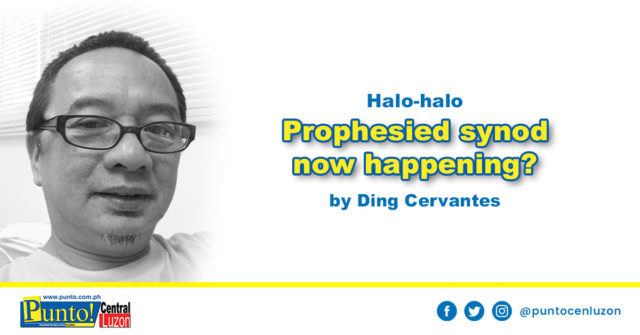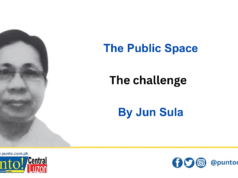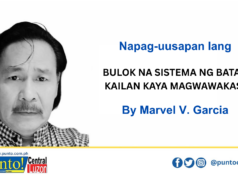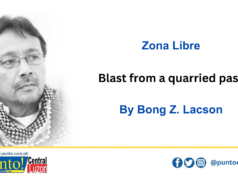IS IT the “synod” now being held in Rome that Garabandal visionary Conchita Gonzalez was referring to as the event that would precede the Blessed Mother’s prophecy of the Warning?
I have this feeling that yes, it is.
To refresh ourselves on Garabandal: from 1961 to 1965, the Blessed Mother appeared to four girls in a hamlet in Garabandal, Spain. The Blessed Mother prophesied conditional events: the Warning that would strike every conscience in the world simultaneously and be triggered by a phenomenon to be seen by all in the sky; the Miracle that would be seen as coming from God and could be televised, seen on internet, and; the Chastisement as punishment for man’s refusal to be good and this would be unprecedented.
They were posited on whether mankind would revert to goodness. This has not happened.
Garabandal has yet to be approved by the Church, but I have put it on the shelf of credibility because then Pope Paul VI had blessed visionary Conchita while Mother Teresa of Calcutta and Padre Pio, both saints now, were reported to have confirmed Garabandal as being supernatural.
There have always been belief that the Garabandal prophecies would all transpire in our times; that millenials would surely be there to experience all three. Being a senior citizen, I am not sure if I would among the experiencers of the horrible chastisement, but I just might be in the circle of the Warning and the Miracle, since, as Conchita had said, these two would happen within a year of each other.
Now if the synod is what Conchita had cited, then I could well be among the world population to be stricken with the Warning. Indeed, the synod seems to be a serious one, in the level that Conchita perceived it to be, as gathered from the Blessed Mother.
The importance of the synod could be refl ected in the call of Cardinal Raymond Burke and Bishop Athanasius Schneider for all Catholics to pray and fast to combat the “serious theological errors and heresies” in the controversial working document for the synod.
They encouraged a 40-day crusade of prayer and fasting beginning on September 17 and ending on October 26, the day before the synod concludes.
Burke and Schneider released an eightpage statement warning of six such heresies contained in the document, or Instrumentum Laboris, which is the source for discussion by the Synod of Bishops taking place in Rome October 6-27.
“The theological errors and heresies, implicit and explicit in the Instrumentum Laboris of the imminent Special Assembly of the Synod of Bishops for the Pan-Amazon, are an alarming manifestation of the confusion, error and division which beset the Church in our day,” the two prelates said in the statement.
“It is our duty to make the faithful aware of some of the main errors that are being spread through the Instrumentum Laboris,” they stated, adding that the working document is “long and is marked by a language which is not clear in its meaning, especially in what regards the deposit of faith (depositum fidei).”
Burke, patron of the Sovereign Order of Malta, and Schneider, auxiliary bishop of Astana, Kazakhstan, are both well-regarded among Catholics for their steady defense of the faith despite all but continual attacks directed at them for upholding it.
They have appealed for prayers and fasting so that Pope Francis, “in the exercise of the Petrine ministry, may confirm his brethren in the faith by an unambiguous rejection of the errors of the Instrumentum Laboris.”
Titled Amazonia, New Paths for the Church and for an Integral Ecology, the document and synod, it is feared, will be used to undermine Church teaching in a number of areas and to advance radical ideas incompatible with Catholic doctrine.
Burke and Schneider have sought prayers so that Pope Francis “may not consent to the abolition of priestly celibacy in the Latin Church by introducing the praxis of the ordination of married men, the so-called ‘viri probati’, to the Holy Priesthood.”
“The Church has no authority whatsoever to confer priestly ordination on women.” The threat to priestly celibacy by way of the synod is of great concern to Catholics, along with an attempt to establish a female “diaconate,” regarded widely as a strategy to push for women “priests” – an impossibility given the Church has no authority to ordain women as Christ chose only men as His apostles.
In his 1994 encyclical Ordinatio Sacerdotalis, the late Pope Saint John Paul II affirmed Church teaching on the matter, stating, “I declare that the Church has no authority whatsoever to confer priestly ordination on women and that this judgment is to be definitively held by all the Church’s faithful.”
The working document suggests discussion of a married priesthood with the priest shortage in the Amazon as rationale.
Among the errors listed by Burke and Schneider is “implicit pantheism” which identifies God as one with the universe, or regards all gods on the same level.
“The Magisterium of the Church rejects such an implicit pantheism as incompatible with the Catholic Faith,” they stated.
The second error identified is that “the pagan superstitions of the Amazon tribes are an expression of Divine Revelation deserving an attitude of dialogue and acceptance on the part of the Church.”
The third concerns the document’s advance of “Intercultural dialogue instead of evangelization.”
“The Instrumentum Laboris contains the erroneous theory that aboriginal people have already received divine revelation, and that the Catholic Church in the Amazon should undergo a ‘missionary and pastoral conversion,’” Burke and Schneider wrote, “instead of introducing doctrine and practice of universal truth and goodness.”
They further add, “the Instrumentum Laboris says also that the Church must enrich herself with the symbols and rites of the aboriginal people.”
“The Magisterium of the Church rejects the idea that missionary activity is merely intercultural enrichment,” they stressed.
Fourth, Burke and Schneider list, “An erroneous conception of sacramental ordination, postulating worship ministers of either sex to perform even shamanic rituals.”
Fifth, that in keeping with “its implicit pantheistic views, the Instrumentum Laboris relativizes Christian anthropology, which recognizes the human person as made in the image of God and therefore the pinnacle of material creation (Gen 1:26-31), and instead considers the human a mere link in nature’s ecological chain, viewing socioeconomic development as an aggression to ‘Mother Earth.’”
Lastly, Burke and Schneider said the working document puts forth “a tribal collectivism that undermines personal uniqueness and freedom,” that is, along with the other errors, rejected by the Magisterium.
They also said that that no one is excused from “being informed about the gravity of the situation and from taking appropriate action for love of Christ and of His life with us in the Church,” and that “all the members of Christ’s Mystical Body, before such a threat to her integrity, must pray and fast for the eternal good of her members who risk being scandalized, that is led into confusion, error and division by this text for the Synod of Bishops.”
The Warning. It is coming, Perhaps in a few months, a few years.





